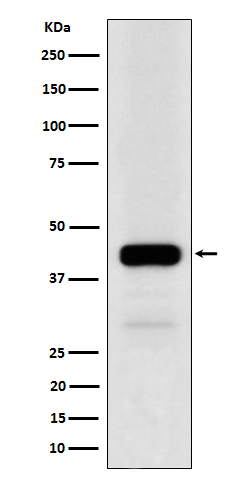NFE2 Antibody
Rabbit mAb
- SPECIFICATION
- CITATIONS
- PROTOCOLS
- BACKGROUND

Application
| WB, IHC, ICC, IP |
|---|---|
| Primary Accession | Q16621 |
| Clonality | Monoclonal |
| Other Names | nfe2 ; Nuclear factor; p45 NFE2; |
| Isotype | Rabbit IgG |
| Host | Rabbit |
| Calculated MW | 41473 Da |
| Dilution | WB 1:500~1:2000 IHC 1:50~1:200 ICC/IF 1:50~1:200 IP 1:50 |
|---|---|
| Purification | Affinity-chromatography |
| Immunogen | A synthesized peptide derived from human NFE2 |
| Description | Component of the NF-E2 complex essential for regulating erythroid and megakaryocytic maturation and differentiation. Binds to the hypersensitive site 2 (HS2) of the beta-globin control region (LCR). |
| Storage Condition and Buffer | Rabbit IgG in phosphate buffered saline , pH 7.4, 150mM NaCl, 0.02% sodium azide and 50% glycerol. Store at +4°C short term. Store at -20°C long term. Avoid freeze / thaw cycle. |
| Name | NFE2 |
|---|---|
| Function | Component of the NF-E2 complex essential for regulating erythroid and megakaryocytic maturation and differentiation. Binds to the hypersensitive site 2 (HS2) of the beta-globin control region (LCR). This subunit (NFE2) recognizes the TCAT/C sequence of the AP-1- like core palindrome present in a number of erythroid and megakaryocytic gene promoters. Requires MAFK or other small MAF proteins for binding to the NF-E2 motif. May play a role in all aspects of hemoglobin production from globin and heme synthesis to procurement of iron. |
| Cellular Location | Nucleus, PML body. Cytoplasm. Note=The sumoylated form locates to the nuclear bodies PML oncogenic domains (PODs) Translocated to the cytoplasm through interaction with ITCH |
| Tissue Location | Expressed in hematopoietic cells and also in colon and testis |

Thousands of laboratories across the world have published research that depended on the performance of antibodies from Abcepta to advance their research. Check out links to articles that cite our products in major peer-reviewed journals, organized by research category.
info@abcepta.com, and receive a free "I Love Antibodies" mug.
Provided below are standard protocols that you may find useful for product applications.
If you have used an Abcepta product and would like to share how it has performed, please click on the "Submit Review" button and provide the requested information. Our staff will examine and post your review and contact you if needed.
If you have any additional inquiries please email technical services at tech@abcepta.com.













 Foundational characteristics of cancer include proliferation, angiogenesis, migration, evasion of apoptosis, and cellular immortality. Find key markers for these cellular processes and antibodies to detect them.
Foundational characteristics of cancer include proliferation, angiogenesis, migration, evasion of apoptosis, and cellular immortality. Find key markers for these cellular processes and antibodies to detect them. The SUMOplot™ Analysis Program predicts and scores sumoylation sites in your protein. SUMOylation is a post-translational modification involved in various cellular processes, such as nuclear-cytosolic transport, transcriptional regulation, apoptosis, protein stability, response to stress, and progression through the cell cycle.
The SUMOplot™ Analysis Program predicts and scores sumoylation sites in your protein. SUMOylation is a post-translational modification involved in various cellular processes, such as nuclear-cytosolic transport, transcriptional regulation, apoptosis, protein stability, response to stress, and progression through the cell cycle. The Autophagy Receptor Motif Plotter predicts and scores autophagy receptor binding sites in your protein. Identifying proteins connected to this pathway is critical to understanding the role of autophagy in physiological as well as pathological processes such as development, differentiation, neurodegenerative diseases, stress, infection, and cancer.
The Autophagy Receptor Motif Plotter predicts and scores autophagy receptor binding sites in your protein. Identifying proteins connected to this pathway is critical to understanding the role of autophagy in physiological as well as pathological processes such as development, differentiation, neurodegenerative diseases, stress, infection, and cancer.


